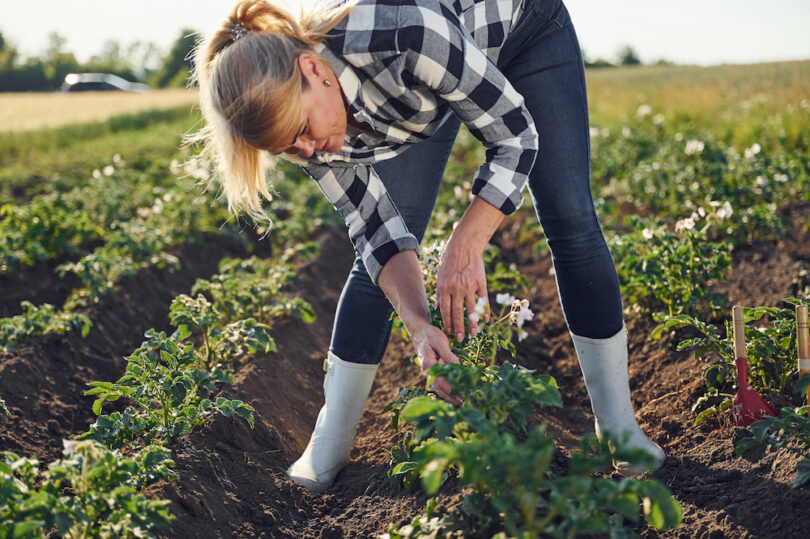This week, the U.S. Department of Agriculture is celebrating the one-year anniversary of the Partnerships for Climate-Smart Commodities funding opportunity’s initial project selection. Joining producers, project leaders, and project partners, Agriculture Secretary Tom Vilsack visited a farm in Wisconsin, where he commemorated the progress made thus far in standing up these initial projects. He highlighted how projects from this effort will raise awareness and implementation at scale of climate-smart production practices, activities, and systems on working lands and with a diverse range of farmers, ranchers, and private landowners, and emphasized how this effort will promote rural prosperity and support the fight against climate change.
“Over the past year, our Partnerships for Climate-Smart Commodities partners have started to hit the ground running, working to enroll farmers and landowners and stand up their projects that hold tremendous promise for both the future of American agriculture and our environment,” Vilsack said. “These wide-ranging, innovative, and forward-looking efforts will not only jumpstart the creation of new markets for climate-smart commodities, but also help producers and forest landowners of all sizes implement climate-smart practices on their lands and pilot innovative and cost-effective methods of quantifying the climate benefits of those practices. I’m excited to see the work that’s been done so far and look forward to seeing these projects continue to progress – as well as their benefits – over the coming months and years.”
USDA is investing more than $3.1 billion for 141 projects through the Partnerships for Climate-Smart Commodities effort, which seeks to build and expand market opportunities for American commodities produced using climate-smart practices through pilot projects, positioning American producers as global leaders in climate-smart agricultural production.
The selected projects – spanning up to five years – will:
- Provide technical and financial assistance to producers to implement climate-smart production practices on a voluntary basis on working lands.
- Pilot innovative and cost-effective methods for quantification, monitoring, reporting and verification (MMRV) of greenhouse gas benefits.
- Develop markets and promote the resulting climate-smart commodities.
All selected projects require meaningful involvement of small and underserved producers. The funding opportunity has earned strong support from a diverse set of stakeholders.
This effort builds on ongoing Biden-Harris Administration initiatives to increase the competitive advantage of U.S. agriculture both domestically and internationally, build wealth that stays in rural communities, and support a diverse range of producers and operation types. This effort also helps to advance the Biden-Harris Administration’s strategy to advance greenhouse gas emissions measurement and monitoring for the agriculture and forest sectors.
Partnerships for Climate-Smart Commodities includes a robust data and learning strategy that includes requirements for grantees to submit the following information as part of their quarterly reporting:
- Progress reports and updates on farm, tract, and field data including, but not limited to, producers enrolled, acres, crops, and livestock covered, climate-smart practices implemented and related incentives;
- Updates on project summary data including geographic data, partner activities, and marketing activities as well as financial and budget information;
- MMRV methods, modeled and measured GHG benefits, and environmental co-benefits including, as applicable water, air, and habitat related benefits.
Other periodic updates on supplemental data, including information related to the MMRV plan and direct field measurement results will also be required. All Partnerships for Climate-Smart Commodities projects will be required to participate in a Partnerships Network, which will bring partners together virtually or in-person on a regular basis to share learnings. USDA will summarize and publish important information from these gatherings, as well as consolidated data from required project reporting.
First-Year Successes
After careful negotiation with partners, USDA has finalized agreements for over 60 large pilot projects with grants ranging from $5 million to $90 million. Many of these projects have already started enrolling producers. Based on the ambitious targets USDA has set with these projects, USDA expects over 1,500 producers to be enrolled by next month encompassing over 1 million acres and over 50,000 head of cattle. USDA also expects to see those numbers more than double by 2024 and continue to grow from there. For example, in Wisconsin, The Delong Company, Inc., has already enrolled over 100 producers, and more broadly in the Midwest, Iowa Soybean Association has already enrolled over 200 producers.
Additionally, USDA has been working to finalize agreements with another 71 smaller pilot projects that have an even greater emphasis on small and underserved producers and minority-serving institutions. More than 25 of those grants already have been finalized. These grants include support to fund efforts of groups like the National Black Growers Council, Iowa Tribe of Kansas and Nebraska and the InterTribal Buffalo Council, the University of Texas Rio Grande, Florida A&M University and Prairie View A&M University.
Further information on active Partnerships for Climate-Smart Commodities projects and finalized grant agreements are being posted on the website on a rolling basis. They can be accessed on the Partnerships for Climate-Smart Commodities Project Summaries page.
USDA touches the lives of all Americans each day in so many positive ways. Under the Biden-Harris Administration, USDA is transforming America’s food system with a greater focus on more resilient local and regional food production, fairer markets for all producers, ensuring access to safe, healthy and nutritious food in all communities, building new markets and streams of income for farmers and producers using climate smart food and forestry practices, making historic investments in infrastructure and clean energy capabilities in rural America, and committing to equity across the Department by removing systemic barriers and building a workforce more representative of America. To learn more, visit www.usda.gov.







